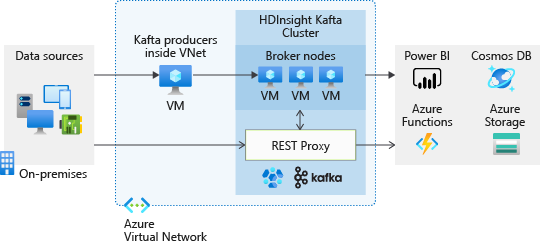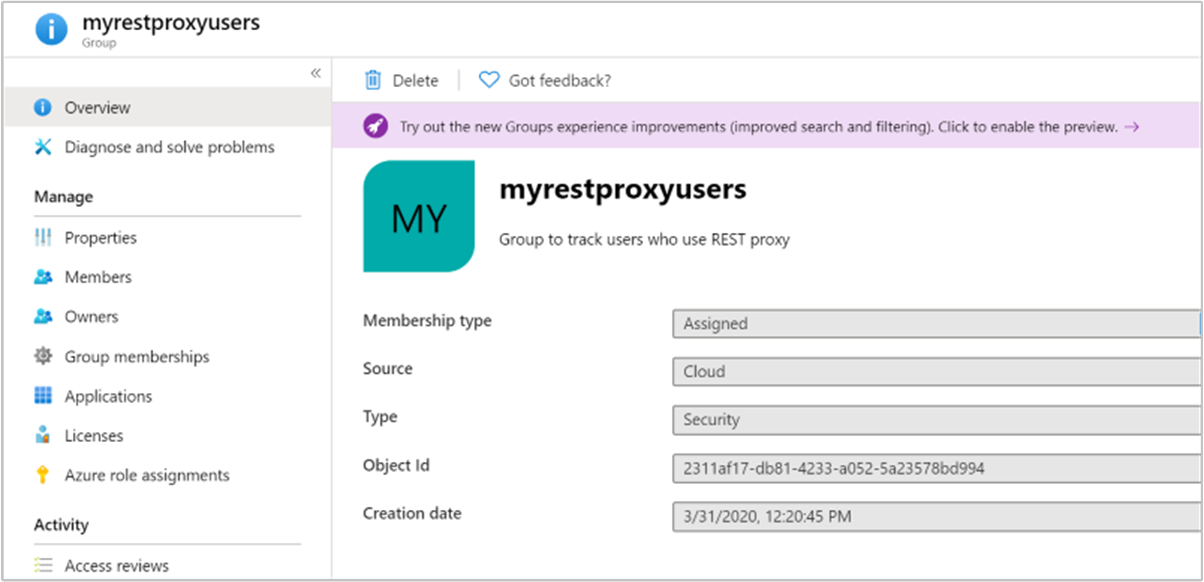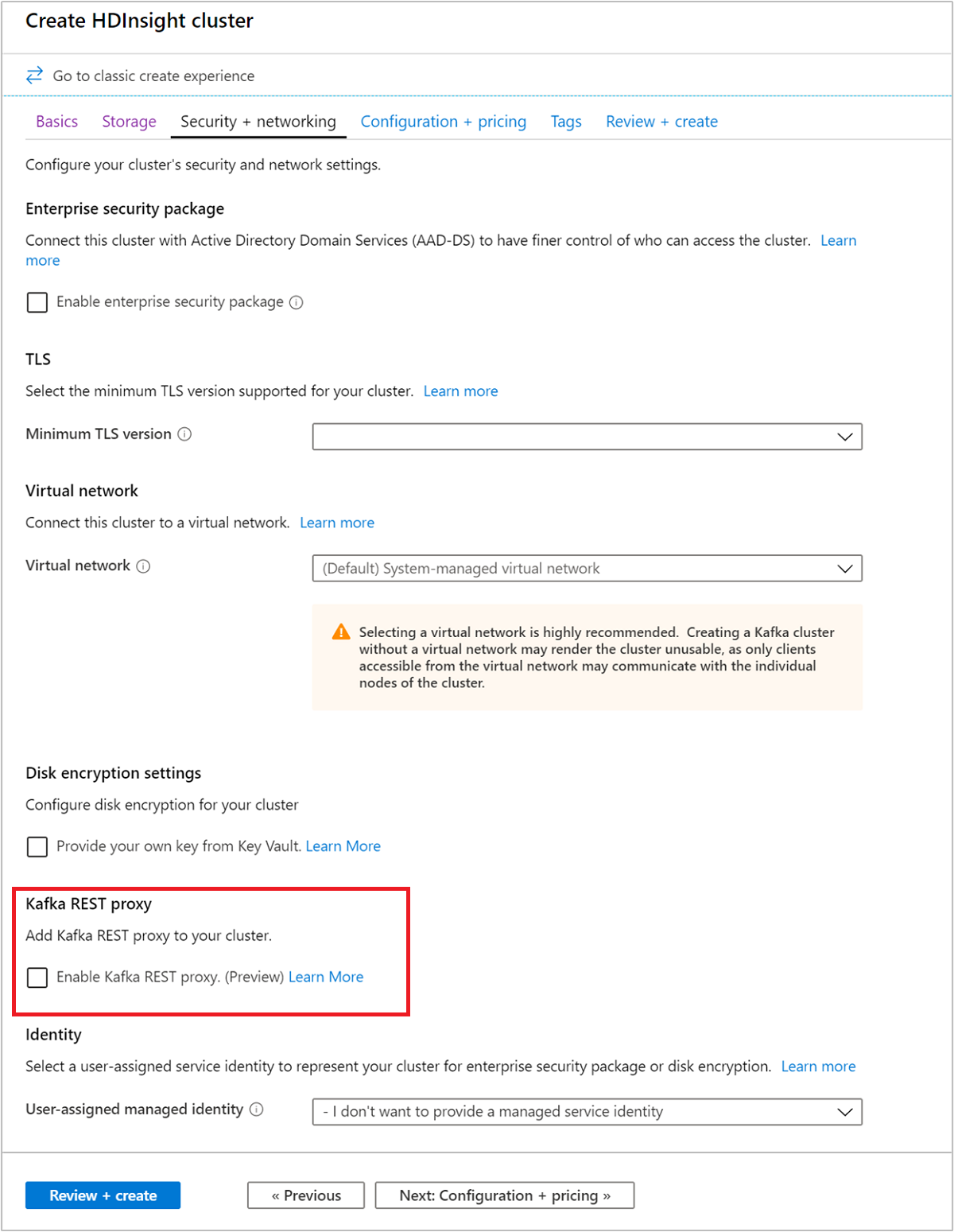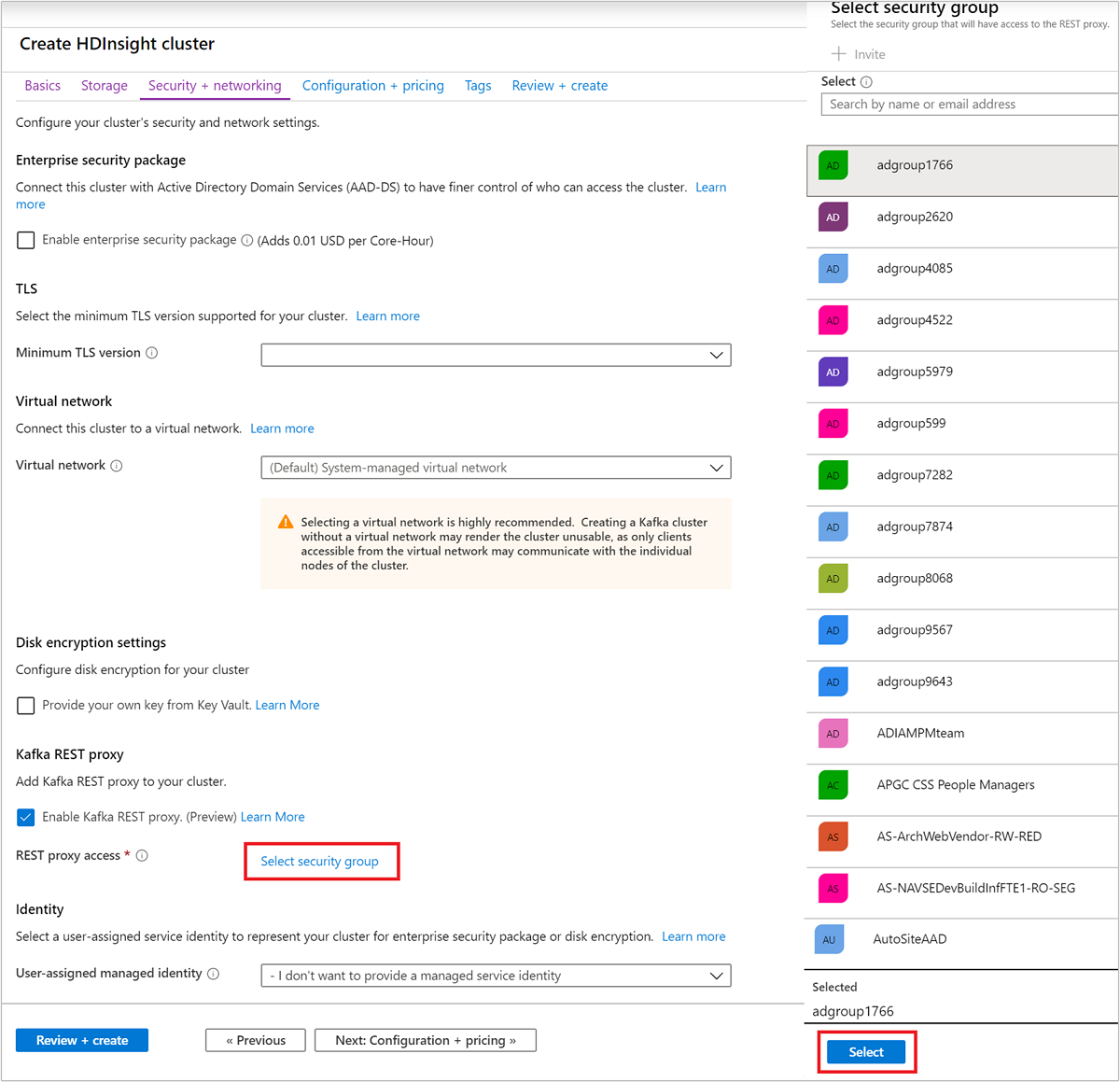REST プロキシを使用して Azure HDInsight で Apache Kafka クラスターを操作する
Kafka REST プロキシを使用すると、HTTPS 経由の REST API を使用して Kafka クラスターを操作することができます。 この操作は、Kafka クライアントを仮想ネットワークの外部に配置できることを意味します。 クライアントは、Kafka ライブラリを利用するのではなく、Kafka クラスターに対して単純かつセキュリティで保護された HTTP 呼び出しを行うことができます。 この記事では、REST プロキシが有効な Kafka クラスターを作成する方法について説明します。 また、REST プロキシを呼び出す方法を示すサンプル コードも提供します。
REST API リファレンス
Kafka REST API によってサポートされる操作については、HDInsight Kafka REST Proxy の API リファレンスを参照してください。
背景

API でサポートされている操作の詳細については、Apache Kafka REST プロキシ API を参照してください。
REST プロキシ エンドポイント
REST プロキシを使用して HDInsight Kafka クラスターを作成すると、クラスターの新しいパブリック エンドポイントが作成されます。これは、Azure portal の HDInsight クラスターの [プロパティ] にあります。
Security
Microsoft Entra セキュリティ グループで管理される Kafka REST プロキシにアクセスします。 Kafka クラスターを作成するときに、Microsoft Entra セキュリティ グループに REST エンドポイント アクセスを提供します。 REST プロキシにアクセスする必要がある Kafka クライアントは、グループの所有者によってこのグループに登録される必要があります。 グループの所有者は、ポータルまたは PowerShell を使用して登録することができます。
REST プロキシ エンドポイント要求の場合、クライアント アプリケーションは OAuth トークンを取得する必要があります。 このトークンは、セキュリティ グループのメンバーシップを確認するために使用されます。 OAuth トークンを取得する方法については、「クライアント アプリケーションのサンプル」を参照してください。 クライアント アプリケーションは、HTTPS 要求の OAuth トークンを REST プロキシに渡します。
Note
Microsoft Entra セキュリティ グループの詳細については、「Microsoft Entra グループを使用したアプリとリソース アクセスの管理」を参照してください。 OAuth トークンのしくみについては、「OAuth 2.0 コード付与フローを使用して Microsoft Entra Web アプリケーションへアクセスを承認する」を参照してください。
ネットワーク セキュリティ グループを使用した Kafka REST プロキシ
独自の VNet を利用し、ネットワーク セキュリティ グループを使用してネットワーク トラフィックを制御する場合は、ポート 443 に加えてポート 9400 で受信トラフィックを許可します。 これにより、Kafka REST プロキシ サーバーにアクセスできるようになります。
前提条件
Microsoft Entra ID でアプリケーションを登録します。 Kafka REST プロキシを操作するために記述するクライアント アプリケーションは、このアプリケーションの ID とシークレットを使用して Azure に対する認証を行います。
Microsoft Entra セキュリティ グループを作成します。 Microsoft Entra ID に登録したアプリケーションをセキュリティ グループにグループのメンバーとして追加します。 このセキュリティ グループは、REST プロキシの操作を許可するアプリケーションを制御するために使用されます。 Microsoft Entra グループの作成方法の詳細については、「Microsoft Entra ID を使用して基本グループを作成してメンバーを追加する」を参照してください。
グループの種類が [セキュリティ] であることを確認します。

アプリケーションがグループのメンバーであることを確認します。

REST プロキシが有効な Kafka クラスターを作成する
この手順では、Azure portal を使用します。 Azure CLI の使用例については、Azure CLI を使用した Apache Kafka REST プロキシ クラスターの作成に関するページを参照してください。
Kafka クラスター作成ワークフローの実行中に、 [セキュリティとネットワーク] タブで、 [Enable Kafka REST proxy](Kafka REST プロキシを有効にする) オプションをオンにします。

[セキュリティ グループの選択] をクリックします。 セキュリティ グループの一覧から、REST プロキシにアクセスするセキュリティ グループを選択します。 検索ボックスを使用して、適切なセキュリティ グループを見つけることができます。 下部にある [選択] ボタンをクリックします。

「Azure portal を使用して Azure HDInsight 内に Apache Kafka クラスターを作成する」の説明に従って、残りのステップを完了してクラスターを作成します。
クラスターが作成されたら、クラスターのプロパティにアクセスして Kafka REST プロキシ URL を記録します。

クライアント アプリケーションのサンプル
Python コードを使用して、Kafka クラスターで REST プロキシを操作できます。 コード サンプルを使用するには、次のステップを実行します。
Python がインストールされているマシンにサンプルコードを保存します。
pip3 install msalを実行して、必要な Python 依存関係をインストールします。実際の環境に合わせて Configure these properties のコード セクションを変更し、次のプロパティを変更します。
プロパティ 説明 テナント ID 該当するサブスクリプションがある Azure テナント。 クライアント ID セキュリティ グループに登録したアプリケーションの ID。 クライアント シークレット セキュリティ グループに登録したアプリケーションのシークレット。 Kafkarest_endpoint この値は、デプロイ セクションの説明に従って、クラスターの概要の [プロパティ] タブから取得します。 https://<clustername>-kafkarest.azurehdinsight.netという形式にする必要があります。コマンド ラインから、
sudo python3 <filename.py>を実行して Python ファイルを実行します
このコードは、次の操作を実行します。
- Microsoft Entra ID からアクセス トークンをフェッチします。
- Kafka REST プロキシに対して要求を行う方法を示します。
Python での OAuth トークンの取得方法の詳細については、Python の AuthenticationContext クラスに関する記事を参照してください。 Kafka REST プロキシで作成または削除されていない topics がそこに反映される間、遅延が発生する可能性があります。 この遅延は、キャッシュの更新によるものです。 Producer API の value フィールドが強化されました。 現在では、JSON オブジェクトとシリアル化されたあらゆる形式を受け取るようになりました。
#Required Python packages
#pip3 install msal
import json
import msal
import random
import requests
import string
import sys
import time
def get_random_string():
letters = string.ascii_letters
random_string = ''.join(random.choice(letters) for i in range(7))
return random_string
#--------------------------Configure these properties-------------------------------#
# Tenant ID for your Azure Subscription
tenant_id = 'ABCDEFGH-1234-1234-1234-ABCDEFGHIJKL'
# Your Client Application Id
client_id = 'XYZABCDE-1234-1234-1234-ABCDEFGHIJKL'
# Your Client Credentials
client_secret = 'password'
# kafka rest proxy -endpoint
kafkarest_endpoint = "https://<clustername>-kafkarest.azurehdinsight.net"
#--------------------------Configure these properties-------------------------------#
# Get access token
# Scope
scope = 'https://hib.azurehdinsight.net/.default'
#Authority
authority = 'https://login.microsoftonline.com/' + tenant_id
app = msal.ConfidentialClientApplication(
client_id , client_secret, authority,
#cache - For details on how look at this example: https://github.com/Azure-Samples/ms-identity-python-webapp/blob/master/app.py
)
# The pattern to acquire a token looks like this.
result = None
result = app.acquire_token_for_client(scopes=[scope])
accessToken = result['access_token']
verify_https = True
request_timeout = 10
# Print access token
print("Access token: " + accessToken)
# API format
api_version = 'v1'
api_format = kafkarest_endpoint + '/{api_version}/{rest_api}'
get_topic_api = 'metadata/topics'
topic_api_format = 'topics/{topic_name}'
producer_api_format = 'producer/topics/{topic_name}'
consumer_api_format = 'consumer/topics/{topic_name}/partitions/{partition_id}/offsets/{offset}?count={count}' # by default count = 1
partitions_api_format = 'metadata/topics/{topic_name}/partitions'
partition_api_format = 'metadata/topics/{topic_name}/partitions/{partition_id}'
# Request header
headers = {
'Authorization': 'Bearer ' + accessToken,
'Content-type': 'application/json' # set Content-type to 'application/json'
}
# New topic
new_topic = 'hello_topic_' + get_random_string()
print("Topic " + new_topic + " is going to be used for demo.")
topics = []
# Create a new topic
# Example of topic config
topic_config = {
"partition_count": 1,
"replication_factor": 1,
"topic_properties": {
"retention.ms": 604800000,
"min.insync.replicas": "1"
}
}
create_topic_url = api_format.format(api_version=api_version, rest_api=topic_api_format.format(topic_name=new_topic))
response = requests.put(create_topic_url, headers=headers, json=topic_config, timeout=request_timeout, verify=verify_https)
print(response.content)
if response.ok:
while new_topic not in topics:
print("The new topic " + new_topic + " is not visible yet. sleep 30 seconds...")
time.sleep(30)
# List Topic
get_topic_url = api_format.format(api_version=api_version, rest_api=get_topic_api)
response = requests.get(get_topic_url, headers={'Authorization': 'Bearer ' + accessToken}, timeout=request_timeout, verify=verify_https)
topic_list = response.json()
topics = topic_list.get("topics", [])
else:
print("Topic " + new_topic + " was created. Exit.")
sys.exit(1)
# Produce messages to new_topic
# Example payload of Producer REST API
payload_json = {
"records": [
{
"key": "key1",
"value": "**********" # A string
},
{
"partition": 0,
"value": 5 # An integer
},
{
"value": 3.14 # A floating number
},
{
"value": { # A JSON object
"id": 1,
"name": "HDInsight Kafka REST proxy"
}
},
{
"value": [ # A list of JSON objects
{
"id": 1,
"name": "HDInsight Kafka REST proxy 1"
},
{
"id": 2,
"name": "HDInsight Kafka REST proxy 2"
},
{
"id": 3,
"name": "HDInsight Kafka REST proxy 3"
}
]
},
{
"value": { # A nested JSON object
"group id": 1,
"HDI Kafka REST": {
"id": 1,
"name": "HDInsight Kafka REST proxy 1"
},
"HDI Kafka REST server info": {
"id": 1,
"name": "HDInsight Kafka REST proxy 1",
"servers": [
{
"server id": 1,
"server name": "HDInsight Kafka REST proxy server 1"
},
{
"server id": 2,
"server name": "HDInsight Kafka REST proxy server 2"
},
{
"server id": 3,
"server name": "HDInsight Kafka REST proxy server 3"
}
]
}
}
}
]
}
print("Payloads in a Producer request: \n", payload_json)
producer_url = api_format.format(api_version=api_version, rest_api=producer_api_format.format(topic_name=new_topic))
response = requests.post(producer_url, headers=headers, json=payload_json, timeout=request_timeout, verify=verify_https)
print(response.content)
# Consume messages from the topic
partition_id = 0
offset = 0
count = 2
while True:
consumer_url = api_format.format(api_version=api_version, rest_api=consumer_api_format.format(topic_name=new_topic, partition_id=partition_id, offset=offset, count=count))
print("Consuming " + str(count) + " messages from offset " + str(offset))
response = requests.get(consumer_url, headers=headers, timeout=request_timeout, verify=verify_https)
if response.ok:
messages = response.json()
print("Consumed messages: \n" + json.dumps(messages, indent=2))
next_offset = response.headers.get("NextOffset")
if offset == next_offset or not messages.get("records", []):
print("Consumer caught up with producer. Exit for now...")
break
offset = next_offset
else:
print("Error " + str(response.status_code))
break
# List partitions
get_partitions_url = api_format.format(api_version=api_version, rest_api=partitions_api_format.format(topic_name=new_topic))
print("Fetching partitions from " + get_partitions_url)
response = requests.get(get_partitions_url, headers={'Authorization': 'Bearer ' + accessToken}, timeout=request_timeout, verify=verify_https)
partition_list = response.json()
print("Partition list: \n" + json.dumps(partition_list, indent=2))
# List a partition
get_partition_url = api_format.format(api_version=api_version, rest_api=partition_api_format.format(topic_name=new_topic, partition_id=partition_id))
print("Fetching metadata of a partition from " + get_partition_url)
response = requests.get(get_partition_url, headers={'Authorization': 'Bearer ' + accessToken}, timeout=request_timeout, verify=verify_https)
partition = response.json()
print("Partition metadata: \n" + json.dumps(partition, indent=2))
curl コマンドを使用して REST プロキシ用のトークンを Azure から取得する方法については、以下の別のサンプルを参照してください。 トークンの取得中に指定された scope=https://hib.azurehdinsight.net/.default が必要であることに注意してください。
curl -X POST -H "Content-Type: application/x-www-form-urlencoded" -d 'client_id=<clientid>&client_secret=<clientsecret>&grant_type=client_credentials&scope=https://hib.azurehdinsight.net/.default' 'https://login.microsoftonline.com/<tenantid>/oauth2/v2.0/token'